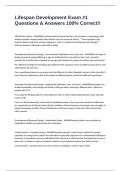Lifespan Development Exam #1
Questions & Answers 100% Correct!!
APA Divison System - ANSWERan instrumental structure that has a lot of power in psychology. Each
division includes changes within that division over the course of history. **Exam question: pick
favorite division and know mission statement - why is it related to development psychology?**
History/context is reflected in what APA is doing
Developmental Research Design: Cross-Sectional (definition, pros, and cons) - ANSWERIn this type of
design, groups of people differing in age are studied at the same point in time. Ask a research
question for one thin slice of people at one age and compare to a group of another age (same time)
Pro: efficient strategy for describing age-related trends; dropouts aren't possible because data is only
collected per person once
Con: something unique to one group could be different for other. Example: seniors in this class didn't
have Tarja but sophomores did so the people in different grades could have different experiences.
Developmental Research Design: Longitudinal (definition, pros, and cons) - ANSWERparticipants are
studied repeatedly, and changes are noted as they get older; same age, different time - affects on
people with 9/11
Pros: good for finding patterns in development; able to study relationships between early and later
events in life
Cons: can be threatened by cohort effects (individuals born in the same time period are influenced
by a particular set of historical and cultural conditions. Results based on one cohort may not apply to
people developing at other times). Participants could move away or drop out of the research for
other reasons
Developmental Research Design: Combination Study - ANSWERseveral similar cross-sectional or
longitudinal studies at varying times are conducted
Critical Period vs. Sensitive Period - ANSWERsensitive period = a time that is optimal for certain
capacities to emerge and in which the individual is especially responsive to environmental influences.
However, its boundaries are less well-defined than those of a critical period. Development can occur
later, but it is harder to induce. sensitive is better to learn before but have the ability to learn.
critical period = a period where you have to learn something in order to get it in life.
,language with critical vs. sensitive periods - ANSWERIn my opinion, language has both sensitive and
critical periods. sensitive period during childhood and critical once child hits puberty. Syntax is
critical, vocabulary is sensitive. Genie's left hemisphere of the brain was not properly developed
which makes scientists believe that language has a critical period at puberty age.
Important realities that can influence development psychology - ANSWERdevelopmental tendencies
(head to talk development), timing (when you're exposed to certain environmental stimuli such as
language), critical/sensitive periods, contextual influences (people are different across contexts)
Paul Bates Developmental Theory - ANSWERneed to look at different experiences that affect our
development
Commonness/Uniqueness of causes of change: normative or non-normative
Further broken up by: normative age-graded influences or normative history-graded influences
Further broken up by classified as biological, psychological, and sociocultural
Normative age-graded influences - ANSWER(age graded influences = events that are strongly related
to age and therefore fairly predictable in when they occur and how long they last are called age-
graded influences).
Normative age - graded
biological: puberty
Psychological - starting high school
Sociocultural - drinking, entering college, getting your license (what's normative in your age group)
Normative history-graded Influences - ANSWERlarge group of people experience at same time in
history - tend to be alike in ways that set them apart from people born at other times
Biological example: major disease, vaccines, HIV; psychological: wartime, racial discrimination
Sociocultural: 9/11, elections
Non-normative influences - ANSWERrare, not necessarily negative
Non-normative sociocultural - tsunami in an environment where it is unlikely to happen
Urie Bronfenbrenner Theory - ANSWERIndividual
Microsystems
Mesosystems
, Exosystems
Macrosystems
Chronosystems
Microsystems - ANSWER(groups within which individual spends time): The innermost level of the
environment, consists of activities and interaction patterns in the person's immediate surroundings.
Example: team, class, family. Each one affects you, you may act differently
Mesosystems - ANSWER(relationships among these microsystems): the second level of
Bronfenbrenner's model, the mesosystem, encompasses connections between microsystems.
Example: mom as your teacher, maybe your teammate is also in your class
Exosystems - ANSWER(systems that influence one even when one spends no time in them): Consists
of social settings that do not contain the developing person but nevertheless affect experiences in
immediate settings. Example: college administration, paid maternity leave/ sick leave
Macrosystems - ANSWER(culture): consists of cultural values, laws, customs, and resources. Example:
when the government provides a generous pension plan for retirees, it supports the well-being of
the elderly.
Chronosystems - ANSWER(time in history): Life changes can be imposed externally or alternatively,
can arise from within the person, since individuals select, modify, and create many of their own
settings and experiences.
Dynamic Systems (Main points, con) - ANSWERHuman experience/behavior are systems that
functions like other systems (e.g., weather changes, mold formation, ice crystal formation)
No "code" for the development of a system
Development is emergent, and contextual, and conditional
Major Con: 2 huge growth spurts - 1st is 2-3 months of age - babies get fat, second spurt in puberty
In Utero Development - Prenatal Development - ANSWERcommonly divided into 3 broad periods:
germinal, embryonic, fetal
Germinal Period - ANSWERweeks 1-2
Conception - Zygote contained within the Zona Pellucida (which eventually disintegrates)




